Philips Bundle
Who Really Owns Philips?
In the ever-shifting world of corporate ownership, understanding who controls a company is crucial. The story of the Philips SWOT Analysis, a global tech giant, offers a fascinating look at how ownership shapes its destiny. From its humble beginnings in 1891, Philips has evolved into a health technology leader, making its ownership structure a key factor in its strategic direction.
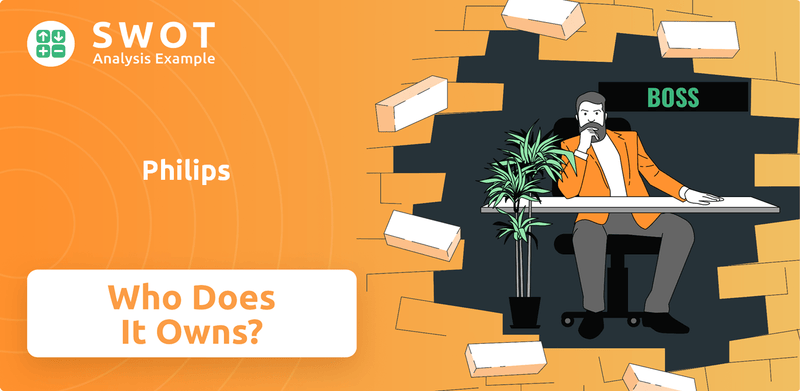
The journey of the Philips company, from a family-run business to a publicly traded entity, reveals much about its resilience and future prospects. Exploring the Philips ownership structure, including its parent company, Koninklijke Philips N.V., provides valuable insights for investors and business strategists. Knowing who owns Philips helps in understanding its commitment to innovation and its long-term financial performance, making it a critical aspect for anyone interested in this enduring global enterprise.
Who Founded Philips?
The story of the Philips company begins in 1891, when Gerard Philips and his father, Frederik Philips, established the company. Their initial focus was on the production of incandescent light bulbs, marking the start of what would become a global technology leader. The early years were very much a family affair, setting the stage for the company's future growth.
Gerard, an engineer, brought the technical expertise, while his father provided the financial backing. The precise equity split at the outset isn't publicly documented, but it's clear that the company was rooted in family ownership. This structure allowed for a unified vision and control during its formative period.
In 1895, Anton Philips, Gerard's brother, joined the company. His commercial skills were instrumental in expanding the business and driving international growth. While the initial funding came from the Philips family, the company's trajectory was shaped by their combined efforts and vision.
Gerard Philips and his father, Frederik Philips, founded the company in 1891.
The initial focus was on manufacturing incandescent light bulbs.
Anton Philips, Gerard's brother, joined in 1895 and significantly contributed to the company's growth.
Initial funding primarily came from the Philips family.
The family maintained direct control, allowing them to shape the company's direction.
There were no major public ownership disputes or buyouts in the early years.
The ownership structure of the Philips company in its early days was firmly in the hands of the Philips family. This family-centric approach facilitated rapid decision-making and a unified vision. The company's early success laid the groundwork for what would become a global entity. To understand more about the company's strategic direction, you can explore the Growth Strategy of Philips.
Philips SWOT Analysis
- Complete SWOT Breakdown
- Fully Customizable
- Editable in Excel & Word
- Professional Formatting
- Investor-Ready Format
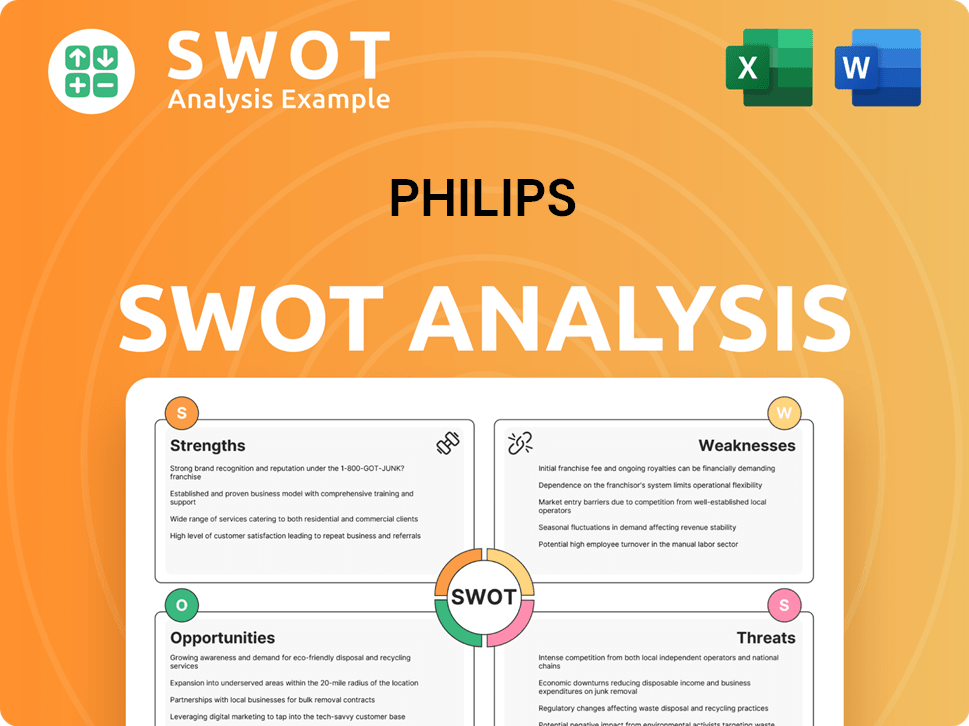
How Has Philips’s Ownership Changed Over Time?
The evolution of the Philips company from a family-run enterprise to a global entity is marked by significant shifts in its ownership structure. Initially, the company operated under family control, but this changed dramatically in 1912 when it was listed on the Amsterdam Stock Exchange. This move was a pivotal moment, opening the door to external investment and setting the stage for future expansion and diversification. Over time, the direct influence of the founding family gradually decreased as the company accessed capital markets and attracted institutional investors.
Today, Philips ownership is primarily held by institutional investors, mutual funds, and individual shareholders. This transition reflects the company's growth and its adaptation to the demands of a global market. As of early 2025, the major shareholders include large asset management firms and pension funds, which collectively hold a substantial portion of the outstanding shares. This shift towards institutional ownership has significantly influenced the company's strategic direction, with a greater emphasis on shareholder value, transparent governance, and a focus on core profitable segments, particularly in health technology.
| Milestone | Year | Impact on Ownership |
|---|---|---|
| Listing on Amsterdam Stock Exchange | 1912 | Transition from family ownership to public ownership, allowing for external investment. |
| Spin-off of Lighting Business (Signify) | 2016 | Strategic divestment to focus on core health technology segments, influenced by market demands and shareholder expectations. |
| Sale of Domestic Appliances Business | 2021 | Further strategic realignment towards health technology, driven by shareholder value and market trends. |
As of early 2025, key institutional investors in Koninklijke Philips N.V. include Capital Research Global Investors, The Vanguard Group, and BlackRock, Inc. These entities collectively hold a significant percentage of the company's stock. For instance, BlackRock, Inc. held approximately 4.9% of the shares as of December 2024. The Vanguard Group held around 5.3% of the shares as of December 2024. These figures are dynamic and subject to change based on quarterly SEC filings and annual reports, reflecting the ongoing adjustments in the Philips company ownership structure.
The Philips parent company is a publicly traded entity, with ownership primarily held by institutional investors.
- Institutional investors like Capital Research Global Investors, The Vanguard Group, and BlackRock, Inc. are major shareholders.
- Strategic decisions, such as divestitures, are influenced by shareholder expectations and market trends.
- The company's focus is on health technology, reflecting a strategic shift driven by financial performance and market opportunities.
- For more insights, consider reading about the company's history and ownership.
Philips PESTLE Analysis
- Covers All 6 PESTLE Categories
- No Research Needed – Save Hours of Work
- Built by Experts, Trusted by Consultants
- Instant Download, Ready to Use
- 100% Editable, Fully Customizable
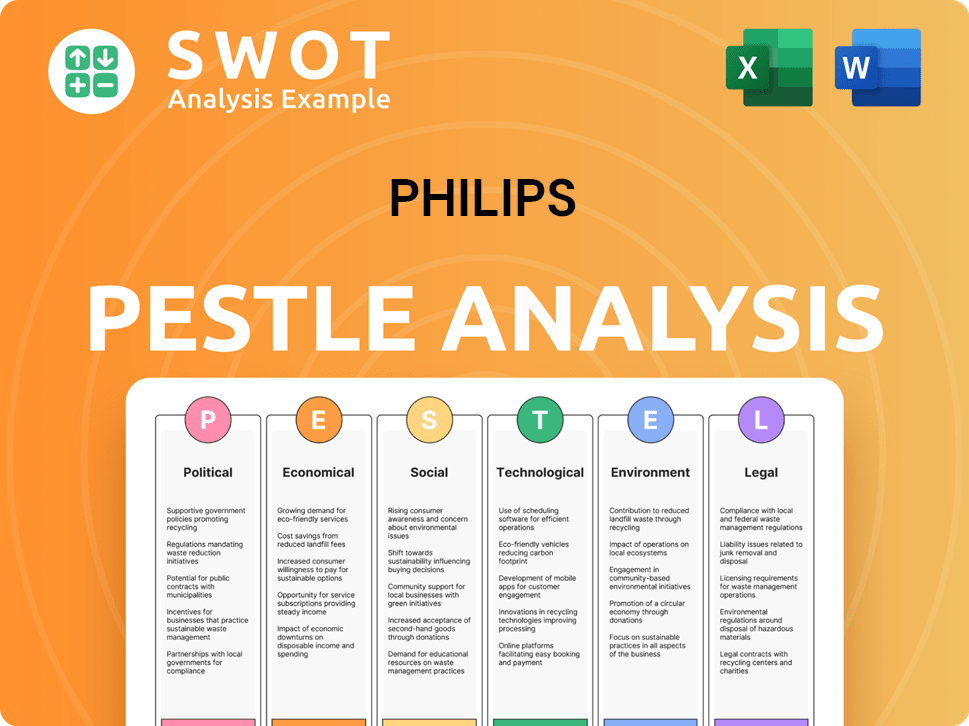
Who Sits on Philips’s Board?
As of early 2025, the governance structure of the Philips company is overseen by a Board of Management and a Supervisory Board. The Supervisory Board, which ensures the Board of Management operates effectively, is primarily composed of independent members. These members bring diverse expertise from fields such as finance, healthcare, and international business. This structure is designed to ensure robust governance and strategic alignment, benefiting all shareholders. The composition of the board does not directly represent major shareholders like Vanguard or BlackRock, but their interests are considered through the board's overall strategic direction.
The Board of Management and Supervisory Board are structured to ensure independent oversight and strategic direction. The company operates under a one-share-one-vote system. This system ensures that each share has equal voting rights. Major institutional investors, due to their significant holdings, wield considerable influence in general meetings, particularly on decisions like board member appointments and strategic directions. While proxy battles are not a constant occurrence, the company remains susceptible to shareholder activism, which can influence decision-making and potentially lead to changes in strategy or governance. The company's commitment to shareholder value is evident in its governance practices.
| Board Role | Description | Key Responsibilities |
|---|---|---|
| Board of Management | Responsible for the day-to-day management of the company. | Setting and executing the company's strategy, managing operations, and ensuring financial performance. |
| Supervisory Board | Oversees the Board of Management and the general course of affairs. | Monitoring the performance of the Board of Management, approving major decisions, and ensuring compliance with regulations. |
| Independent Directors | Members of the Supervisory Board who are not affiliated with the company's management or major shareholders. | Providing independent oversight, ensuring accountability, and representing the interests of all shareholders. |
The voting structure at Philips is designed to be democratic, with each share holding equal voting rights. This structure allows significant influence from large institutional investors. Shareholder activism can shape decision-making. For a deeper understanding of the company's approach to the market, explore the Marketing Strategy of Philips.
Philips operates under a one-share-one-vote system, ensuring equal voting rights for all shareholders.
- The Supervisory Board oversees the Board of Management.
- Independent directors play a crucial role in governance.
- Institutional investors have significant influence through their holdings.
- Shareholder activism can impact decision-making.
Philips Business Model Canvas
- Complete 9-Block Business Model Canvas
- Effortlessly Communicate Your Business Strategy
- Investor-Ready BMC Format
- 100% Editable and Customizable
- Clear and Structured Layout
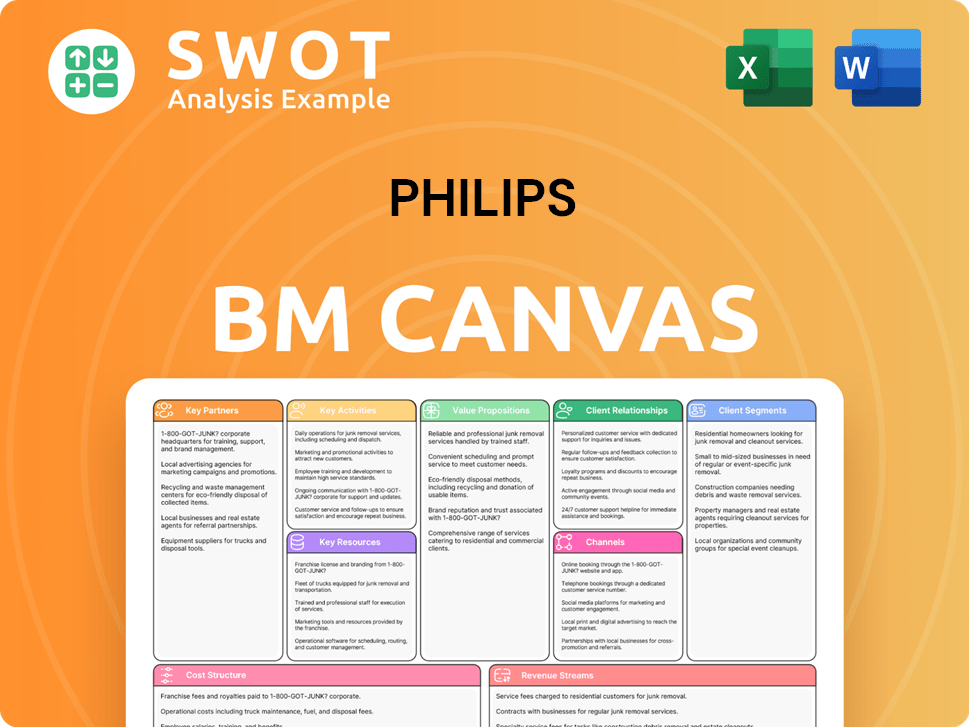
What Recent Changes Have Shaped Philips’s Ownership Landscape?
Over the past few years, the ownership of the Philips company has been significantly shaped by its strategic shift towards health technology and the impact of product recalls. The sale of its Domestic Appliances business in 2021 streamlined the company's portfolio, influencing its valuation and shareholder base. Leadership changes, including Roy Jakobs becoming CEO in October 2022, have also played a role in investor sentiment and strategic direction. These changes are part of a broader trend impacting many multinational corporations.
The ongoing Respironics recall has led to increased investor scrutiny and a re-evaluation of risk profiles by some institutional holders. Industry trends indicate a growing emphasis on ESG (Environmental, Social, and Governance) factors among institutional investors, which likely influences Philips' strategic decisions and reporting. There is a general trend of increased institutional ownership in large multinational corporations, and Philips ownership is no exception, with large asset managers continuing to hold substantial stakes.
| Metric | Data (as of late 2024/early 2025) | Source |
|---|---|---|
| Market Capitalization | Approximately $25 billion USD | Financial News Outlets |
| Institutional Ownership | Around 70-75% | Financial Data Providers |
| Revenue (2024) | Expected to be around €18-19 billion | Company Financial Reports |
The focus for Koninklijke Philips N.V. remains on executing its strategy, resolving the recall issues, and driving growth in its health technology segments. These factors will continue to shape its ownership profile. For more information about the company's target market, you can read this article on the Target Market of Philips.
Increased institutional ownership is a notable trend, with major asset managers holding substantial stakes. The company's focus is on health technology, which is driving strategic decisions. The Respironics recall has led to investor scrutiny and risk profile re-evaluation.
The sale of the Domestic Appliances business streamlined the portfolio. Leadership changes, such as the appointment of Roy Jakobs, have influenced investor sentiment. These decisions are part of a broader strategy to focus on the health technology sector.
The company's market capitalization is approximately $25 billion USD. Revenue in 2024 is expected to be around €18-19 billion. The financial performance is closely tied to resolving the recall issues and strategic execution.
The company is focused on growth in health technology. ESG factors are likely to influence strategic decisions. The ownership profile will continue to evolve based on these factors.
Philips Porter's Five Forces Analysis
- Covers All 5 Competitive Forces in Detail
- Structured for Consultants, Students, and Founders
- 100% Editable in Microsoft Word & Excel
- Instant Digital Download – Use Immediately
- Compatible with Mac & PC – Fully Unlocked
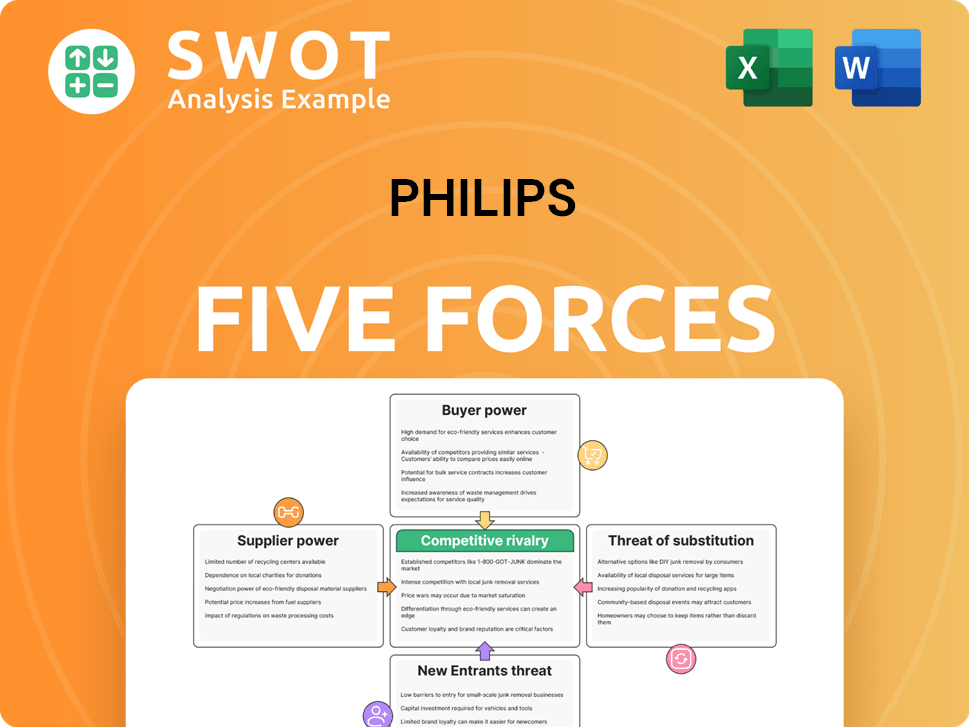
Related Blogs
- What are Mission Vision & Core Values of Philips Company?
- What is Competitive Landscape of Philips Company?
- What is Growth Strategy and Future Prospects of Philips Company?
- How Does Philips Company Work?
- What is Sales and Marketing Strategy of Philips Company?
- What is Brief History of Philips Company?
- What is Customer Demographics and Target Market of Philips Company?
Disclaimer
All information, articles, and product details provided on this website are for general informational and educational purposes only. We do not claim any ownership over, nor do we intend to infringe upon, any trademarks, copyrights, logos, brand names, or other intellectual property mentioned or depicted on this site. Such intellectual property remains the property of its respective owners, and any references here are made solely for identification or informational purposes, without implying any affiliation, endorsement, or partnership.
We make no representations or warranties, express or implied, regarding the accuracy, completeness, or suitability of any content or products presented. Nothing on this website should be construed as legal, tax, investment, financial, medical, or other professional advice. In addition, no part of this site—including articles or product references—constitutes a solicitation, recommendation, endorsement, advertisement, or offer to buy or sell any securities, franchises, or other financial instruments, particularly in jurisdictions where such activity would be unlawful.
All content is of a general nature and may not address the specific circumstances of any individual or entity. It is not a substitute for professional advice or services. Any actions you take based on the information provided here are strictly at your own risk. You accept full responsibility for any decisions or outcomes arising from your use of this website and agree to release us from any liability in connection with your use of, or reliance upon, the content or products found herein.